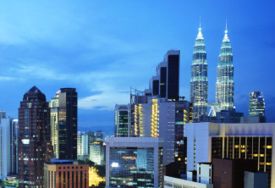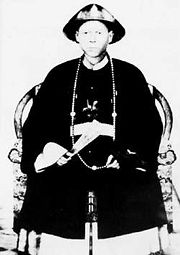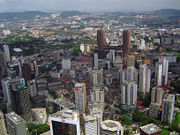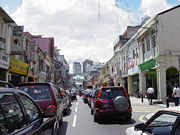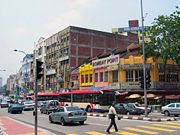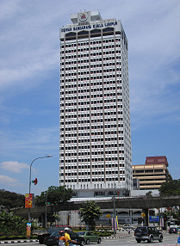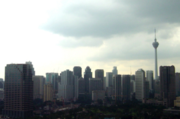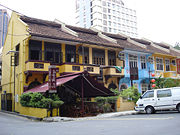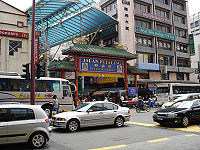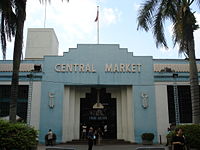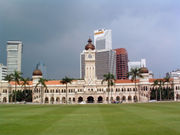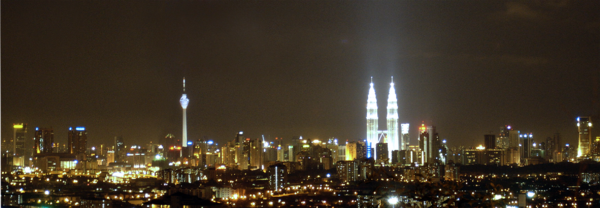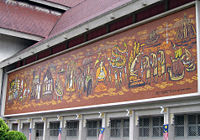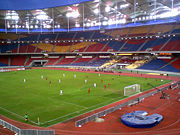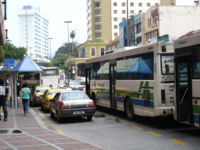Kuala Lumpur
2008/9 Schools Wikipedia Selection. Related subjects: Geography of Asia
| Kuala Lumpur كوالا لومڤور |
|||
|
|||
| Nickname(s): "KL" | |||
| Motto: Maju dan makmur (English: Progress and Prosper) |
|||
| Location in Malaysia | |||
| Coordinates: | |||
|---|---|---|---|
| Country | Malaysia | ||
| State | Federal Territory | ||
| Establishment | 1857 | ||
| Granted city status | 1972 | ||
| Granted Federal Territory | 1974 | ||
| Government | |||
| - Mayor (Datuk Bandar) | Datuk Abdul Hakim Borhan From 14 December 2006 |
||
| Area | |||
| - City | 243.65 km² (95.18 sq mi) | ||
| Elevation | 21.95 m (72 ft) | ||
| Population (2007) | |||
| - City | 1,887,674 ( 1st) | ||
| - Density | 7,388/km² (18,912/sq mi) | ||
| - Metro | 7.2 million | ||
| - Demonym | KL-ite / Kuala Lumpurian | ||
| Time zone | MST ( UTC+8) | ||
| - Summer ( DST) | Not observed ( UTC+8) | ||
| Postal code | 50xxx to 60xxx 68xxx |
||
| Mean solar time | UTC + 06:46:48 | ||
| National calling code | 03 | ||
| License plate prefix | Wxx (for all vehicles except taxis) HWx (for taxis only) |
||
| ISO 3166-2 | MY-14 | ||
| Website: Official Kuala Lumpur Website | |||
Kuala Lumpur (pronounced /ˈkwɑːləlʊmˈpʊər/, Malay /kwɑlɑlʊmpʊ/ and locally /kwɑləlʊmpɔ/ or even /kɔlɔmpɔ/), or often abbreviated as K.L., is the capital and the largest city of Malaysia. The city proper, making up an area of 244 km2, has an estimated population of 1.6 million in 2006. Greater Kuala Lumpur, also known as Klang Valley, is an urban agglomeration of 7.2 million. It is the fastest growing metropolitan region in the country, in terms of population as well as economy.
Kuala Lumpur is the seat of the Parliament of Malaysia, making it the country's legislative capital. The city was once home to the executive and judicial branches of the federal government, but they have since moved to Putrajaya starting in 1999. Some sections of the judiciary remain in the capital. The official residence of the Malaysian King, the Istana Negara, is also situated in Kuala Lumpur. The city is also the cultural and economic centre of Malaysia due to its position as the capital as well as being a primate city. Kuala Lumpur is rated as a gamma world city, and is the only global city in Malaysia.
Kuala Lumpur is defined within the borders of the Federal Territory of Kuala Lumpur and is one of three Malaysian Federal Territories. It is an enclave within the state of Selangor, on the central west coast of Peninsular Malaysia. Residents of the city are known as KLites.
Beginning in the 1990s, the city has played host to many international sporting, political and cultural events including the 1998 Commonwealth Games and the Formula One World Championship. In addition, Kuala Lumpur is home to the tallest twin buildings in the world, the Petronas Twin Towers.
History
Kuala Lumpur has its origins in the 1850s, when the Malay Chief of Klang, Raja Abdullah, hired some Chinese labourers to open new and larger tin mines. They landed at the confluence of Sungai Gombak and Sungai Klang ( Klang River) to open mines at Ampang. Sungai Gombak was previously known as Sungai Lumpur, which means muddy river. The city thus derived the name Kuala Lumpur which literally means “muddy confluence” in Bahasa Melayu. Later, tin mines were opened at Pudu and Batu. Among the early notable pioneers are Hiu Siew and Liu Ngim Kong.
These mines became a trading post and was considered a frontier town with many problems including the Selangor Civil War; it was also plagued by diseases and constant fires and floods. Around the 1870s, the Chinese Kapitan of Kuala Lumpur, Yap Ah Loy, emerged as leader, and became responsible for the survival and subsequent systematic growth of this town. In 1880, the state capital of Selangor was moved from Klang to the more strategically advantageous Kuala Lumpur.
In 1881, a flood swept through the town following a fire which engulfed it earlier. These successive problems destroyed the town's structures of wood and atap ( thatching). As a response, Frank Swettenham, the British Resident of Selangor, required that buildings be constructed of brick and tile. Many of the new brick buildings mirrored that of shop houses in southern China, with " five foot ways" as well as skilled Chinese carpentry. This resulted in a distinct eclectic shop house architecture typical to this region. A railway line increased accessibility into this town. Development intensified in the 1890s, leading to the creation of a Sanitary Board. In 1896, Kuala Lumpur was chosen as the capital of the newly formed Federated Malay States.
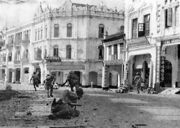
A mixture of different communities settled in various sections of Kuala Lumpur. The Chinese mainly settled around the commercial centre of Market Square, east of Klang River, and towards Chinatown. The Malays, Indian Chettiars, and Indian Muslims resided along Java Street (now Jalan Tun Perak). The Padang, now known as Merdeka Square, was the centre of the British administrative offices.
During World War II, Kuala Lumpur was captured by the Japanese army on January 11, 1942. They remained in occupation until August 15, 1945, when the commander in chief of the Japanese Seventh Area Army in Singapore and Malaya, Seishirō Itagaki, surrendered to the British administration following the Atomic bombings of Hiroshima and Nagasaki. Kuala Lumpur grew through the war, the rubber and tin commodity crashes and the Malayan Emergency, during which Malaya was preoccupied with the communist insurgency. In 1957, the Federation of Malaya gained its independence from British rule. Kuala Lumpur remained the capital through the formation of Malaysia on September 16, 1963.
On May 13, 1969, one of the worst race riots in Malaysia took place in Kuala Lumpur. The May 13 Incident was a riot between the Malays and the Chinese who were dissatisfied with the socio-political situation at the time. The riot resulted in the deaths of 196 people, and led to a major reform in the country's economic policy.
Kuala Lumpur later achieved city status in 1972, becoming the first settlement in Malaysia to be granted the status after independence. Later, on February 1, 1974, Kuala Lumpur became a Federal Territory. Kuala Lumpur ceased to be the capital of Selangor in 1978 after the city of Shah Alam was declared as the new state capital.
In 1998, another political movement known as Reformasi took place mainly in this city. The movement was a result of the sacking of former Malaysian Deputy Prime Minister, Anwar Ibrahim, and resulted in a chain of protests until 1999, where supporters of Anwar Ibrahim took to the streets to demand reforms in the government's administration, among others.
On February 1, 2001, Putrajaya was declared a Federal Territory, as well as the seat of the federal government. The administrative and judicial functions of the government were shifted from Kuala Lumpur to Putrajaya. Kuala Lumpur however still retained its legislative function, and remained the home of the Yang di-Pertuan Agong (King).
In November 2007, two of the largest political rallies since 1998 took place in the city—the Bersih rally on November 10 and the HINDRAF rally on November 25. The Bersih rally was organised by a number of non-governmental organisations and opposition political parties to demand electoral reform in the country with about 50,000 people taking to the streets. The HINDRAF rally was organised by HINDRAF (Hindu Rights Action Front) and was attended by at least 30,000 mainly ethnic Indian protesters demanding equal social and economic rights from the Bumiputras.
Geography
The geography of Kuala Lumpur is characterized by a huge valley known as Klang Valley. The valley is bordered by the Titiwangsa Mountains in the east, several minor ranges in the north and the south and the Strait of Malacca in the west. Kuala Lumpur is a Malay term which translates to "muddy confluence" as it is located at the confluence of the Klang and Gombak rivers.
Located in the centre of Selangor state, Kuala Lumpur was previously under the rule of Selangor State Government. In 1974, Kuala Lumpur was separated from Selangor to form the first Federal Territory governed directly by the Malaysian Federal Government. Its location on the west coast of Peninsular Malaysia, which has wider flat land than the east coast, has contributed to its faster development relative to other cities in Malaysia.
The municipality of the city covers an area of 243.65 km2 (94.07 sq mi), with an average elevation of 21.95 m (72 ft).
Weather
Protected by the Titiwangsa Mountains in the east and Indonesia's Sumatra Island in the west, Kuala Lumpur has a year-round equatorial climate which is warm and sunny, along with plentiful rainfall, especially during the southwest monsoon from September to April. Temperatures tend to remain constant. Maximums hover between 31°C and 33°C (88-92°F) and have never exceeded 37°C (99°F), while minimums hover between 22°C and 23.5°C (71-74°F) and have never fallen below 19°C (66°F). Kuala Lumpur typically receives 2,266 mm (93.1") of rain annually; June and July are relatively dry, but even then rainfall typically exceeds 125 mm (5") per month.
Flooding is a frequent occurrence in Kuala Lumpur whenever there is a heavy downpour, especially in the city centre and downstream areas. Dust particles from forest fires from nearby Sumatra sometimes cast a haze over the region. It is a major source of pollution in the city together with open burning, emission from motor vehicles and construction work.
| Weather averages for Kuala Lumpur | |||||||||||||
|---|---|---|---|---|---|---|---|---|---|---|---|---|---|
| Month | Jan | Feb | Mar | Apr | May | Jun | Jul | Aug | Sep | Oct | Nov | Dec | Year |
| Record high °C | 35 | 36 | 37 | 36 | 35 | 36 | 36 | 36 | 35 | 36 | 35 | 34 | |
| Average high °C | 31.9 | 32.8 | 33.1 | 33.0 | 32.8 | 32.5 | 32.1 | 32.2 | 31.9 | 31.8 | 31.4 | 31.5 | 32.3 |
| Average low °C | 22.1 | 22.3 | 22.8 | 23.4 | 23.1 | 22.1 | 22.7 | 22.7 | 22.7 | 22.9 | 22.9 | 22.5 | 22.7 |
| Record low °C | 19 | 21 | 20 | 21 | 22 | 20 | 19 | 19 | 20 | 21 | 21 | 19 | |
| Precipitation mm | 162 | 145 | 218 | 285 | 184 | 127 | 129 | 146 | 192 | 272 | 275 | 230 | 2,266 |
| Record high °F | 95 | 96.8 | 98.6 | 96.8 | 95.0 | 96.8 | 96.8 | 96.8 | 95.0 | 96.8 | 95.0 | 93.2 | |
| Average high °F | 89.4 | 91.0 | 91.6 | 91.4 | 91.6 | 90.5 | 89.8 | 90.0 | 89.4 | 89.2 | 88.5 | 88.7 | 90.0 |
| Average low °F | 71.8 | 72.1 | 73.0 | 74.1 | 73.6 | 71.8 | 72.9 | 72.9 | 72.9 | 73.2 | 73.2 | 72.5 | 72.8 |
| Record low °F | 66.2 | 69.8 | 68 | 69.8 | 71.6 | 68 | 66.2 | 66.2 | 68 | 69.8 | 69.8 | 66.2 | |
| Precipitation inches | 6.4 | 5.7 | 8.6 | 11.2 | 7.2 | 5.0 | 5.1 | 5.7 | 7.6 | 10.7 | 10.8 | 9.1 | 93.1 |
| Source: National Environment Agency, Singapore. Jan 2007 | |||||||||||||
Demographics
Kuala Lumpur also has a mix of different cultures. Unlike the whole of Malaysia, where Malays comprise the ethnic majority, the majority of Kuala Lumpur residents are Chinese. Other major cultures represented include Indians, Eurasians, as well as Kadazans, Ibans and other indigenous races from East Malaysia and Peninsula Malaysia.
Malays speak the national language of Bahasa Melayu and are also able to converse in English; some even Mandarin and Tamil. Malays form the bulk of the members of Parliament and dominate the political scene in Malaysia..
In the late-18th century, when Europe was experiencing the Industrial Revolution, large groups of Chinese from Fujian and Guangdong in China were brought in to Malaya to work in the booming tin mining industry. The Chinese in Kuala Lumpur speak different dialects but the majority in Kuala Lumpur are of Cantonese descent, followed by the Hokkiens and the Hakkas. Similarly, due to the education system provided by the government, many Chinese in Kuala Lumpur are able to converse in English, Bahasa Malaysia, Mandarin and are able to bridge the divide among the local dialects.
Indians formed 10% of the population in Kuala Lumpur in 2000. Historically, most of the Indians were brought in during the British colonisation of the Malaysia. Most Indians practise Hinduism and speak Tamil or Hindi and English. Most of their customs and traditions are intricately tied with their religion. Hence, during the Hindu festivals such as Deepavali, Indians will perform colourful rites and visit temples.
Malay is the official language but English is widely spoken in the city especially in business and is a required subject in all schools. Chinese dialects (Cantonese, Mandarin, Hakka, Hokkien, Hainan) and some Indian and Pakistani languages (Tamil, Telugu, Malayalam, Punjabi, Pashtu) as well as the languages of migrant workers (Indonesian, Nepalese, Vietnamese, etc.) are also spoken in the city.
The city has many places of worship catering to the multi-religious population. Islam is practised primarily by the Malays and the Indian Muslim communities while other religions include Buddhism, Confucianism and Taoism (mainly among Chinese), Hinduism (among Indians) and Christianity.
Due to the rapid development in Malaysia and Kuala Lumpur which requires a large workforce, foreign workers from Indonesia, Nepal, Burma, Thailand, Bangladesh, Vietnam and China were brought into Malaysia.
Population statistics
The estimated population of Kuala Lumpur in 2006 was 1.58 million. With a population density of 6,502 people per km2, it is the most densely populated administrative district in Malaysia. With an estimated metropolitan population of 6.9 million in 2007, it can be considered a primate city. The continuing decline in the birth rate for Kuala Lumpur has resulted in the decline in the proportion of young people below 15 years old from 33% in 1980 to slightly less than 27% in 2000. On the other hand, the working age group of 15-59 increased from 63% in 1980 to 67% in 2000. The elderly age group, 60 years old and above has increased from 4% in 1980 and 1991 to 6% in 2000.
Based on the census of the Department of Statistics, the percentage of Bumiputra population was around 38% in 2000 while the Chinese population comprised 43% and Indians 10%. A notable phenomenon has been the increase in the presence of foreign residents in Kuala Lumpur, who now constitute about 9% of the city’s population.
Crime in Kuala Lumpur has been a concern of residents in recent years. Among the crimes showing increasing rates were snatch theft, drug addiction, gambling and vice.. These problems have been associated with the rising numbers of immigrants from Indonesia and Myanmar. Some of them are brought in with the promise of low to medium grade salary.
Government
Local government
The local administration is carried out by the Kuala Lumpur City Hall, an agency under the Federal Territories Ministry of Malaysia. They are responsible for public health and sanitation, waste removal and management, town planning, environmental protection and building control, social and economic development and general maintenance functions of urban infrastructure. Executive power lies with the mayor in the city hall, who is appointed for three years by the Federal Territories Minister. This system of appointing the mayor has been in place ever since the local government elections were suspended in 1970.
Since Kuala Lumpur became a Federal Territory of Malaysia on February 1, 1974, the city has been led by eight mayors. The current mayor of Kuala Lumpur is Datuk Abdul Hakim Borhan, who is in his first term of office. He was appointed in 2006.
Politics
Kuala Lumpur is home to the Parliament of Malaysia. The parliament is composed of a lower House of Representatives (Dewan Rakyat) and an upper House of Senate (Dewan Negara). The city is represented in the lower House of Representatives by eleven Members of Parliament (MPs), who are elected to five-year terms. Traditionally, political leanings in Kuala Lumpur have been dominated by Barisan Nasional (BN), with seven representatives from BN and the other four from the Democratic Action Party (DAP) prior to the 2008 General Elections. After the 2008 elections BN was left with just one representative, Federal Territories Minister Zulhasnan Rafique, in the Setiawangsa seat. DAP took control of five seats, Parti Keadilan Rakyat taking four seats, and PAS one seat, marking the first time in which the majority of the Federal Territory's constituencies was dominated by opposition parties.
Economy
Kuala Lumpur and its surrounding urban areas form the most industrialized and economically the fastest growing region in Malaysia. Despite the relocation of federal government administration to Putrajaya, certain government’s important machineries such Bank Negara Malaysia (Central Bank of Malaysia), Companies Commission of Malaysia and Securities Commission as well as most embassies and diplomatic missions have remained in the city.
In short the city remains the economic and business center of the country. In fact the city is a centre for finance, insurance, real estate, media and the arts in Malaysia. The infrastructure development in the surrounding areas such as the Kuala Lumpur International Airport at Sepang, the creation of the Multimedia Super Corridor and the expansion of Port Klang further reinforce the economic significance of the city.
Bursa Malaysia or the Malaysia Exchange is based in the city and forms one of its core economic activities. As of 20 November 2007, the market capitalisation stood at US$318.65 billion.
The Gross Domestic Product (GDP) for Kuala Lumpur is estimated at RM25,968 million in 2000 with an average annual growth rate of 4.2 percent. The per capita GDP for Kuala Lumpur in year 2000 is RM30,727, an average annual growth rate of 6.1 percent. The total employment in Kuala Lumpur is estimated at around 838,400. The service sector comprising finance, insurance, real estate, business services, wholesale and retail trade, restaurants and hotels, transport, storage and communication, utilities, personal services and government services form the largest component of employment representing about 83.0 percent of the total. The remaining 17 percent comes from manufacturing and construction.
The large service sector is evident in the number of local and foreign banks and insurance companies operating in the city. Kuala Lumpur is poised to become the global Islamic Financing hub with an increasing number of financial institutions providing Islamic Financing and the strong presence of Gulf's financial institutions such as the world's largest islamic bank, Al-Rajhi Bank and Kuwait Finance House. Apart from that, the Dow Jones & Company is keen to work with Bursa Malaysia to set up Islamic Exchange Trade Funds (ETFs), which would help raise Malaysia's profile in the Gulf. The city has a large number of foreign corporations and is also host to many multi national companies’ regional offices or support centres, particularly for finance and accounting, and information technology functions. Most of the countries’ largest companies have their headquarters based here and as of December 2007 and excluding Petronas, there are 14 companies that are listed in Forbes 2000 based in Kuala Lumpur.
Other important economic activities in the city are education and health services. Kuala Lumpur also has advantages stemming from the high concentration of educational institutions located within its boundaries, providing a wide range of courses. Such public institutions include the University of Malaya, the Universiti Teknologi Malaysia, International Medical University and the Medical Faculty of the Universiti Kebangsaan Malaysia. There are also a large number of private colleges, including the Universiti Tun Abdul Razak and Tunku Abdul Rahman College, in and around Kuala Lumpur providing a wide range of courses which attract students from all over Malaysia as well as from other countries. There are numerous public and private medical specialist centres and hospitals in the city which offer general health services and a wide range of specialist surgery and treatment catering to locals and tourists.
There has been growing emphasis to expand the economic scope of the city into other service activities such as research and development which supports the rest of the economy of Malaysia. Kuala Lumpur has been home for years to important research centers such as the Rubber Research Institute of Malaysia, the Forest Research Institute Malaysia and the Institute of Medical Research and more research centers are expected to be established in the coming years.
Tourism
The tourism sector also plays an important part in the city’s economy, providing income, employment and expanding business opportunities. As an extension of this, many large worldwide hotel chains have presence in the city. Kuala Lumpur has also developed into an international shopping destination with a wide variety of shopping centres and mega malls which carry well-known global and local brands. Conference tourism has also expanded in recent years and is becoming a very important component of the industry.
Major destinations include the House of Parliament, Kuala Lumpur Tower, Putra World Trade Centre, Dataran Merdeka, Tugu Negara, Istana Negara, Istana Budaya, mosque such as the Masjid Negara and the Federal Territory Mosque, Muzium Negara, and other tourist attractions including Aquaria KLCC, Makam Pahlawan, National Science Centre, Eye on Malaysia, Zoo Negara, Batu Caves, and events such as the Chinese cultural festivals at the Thean Hou Temple and the Thaipusam procession at the Sri Mahamariamman Temple. The Golden Triangle, the commercial hub of the city, contains the Petronas Twin Towers and has a distinctive nightlife. Trendy nightclubs, bars and lounges, such as Hard Rock Cafe, Zouk, Thai Club, Beach Club (voted Best Bar in Asia), Luna Bar, Rum Jungle, Nuovo, Espanda and many others are located within and around Jalan P. Ramlee, Jalan Sultan Ismail and Jalan Ampang.
Hotels, from five-star to budget types, have cropped up everywhere to accommodate the influx of tourists each year. While there are many hotels near Kuala Lumpur's entertainment and business districts, some have chosen to veer away from the hustle and bustle.
Retail
Kuala Lumpur alone has 66 shopping malls and it is the retail and fashion hub for Malaysia. Shopping in Malaysia contributes RM7.7 billion (USD 2.26 billion) or 20.8 percent of the RM31.9 billion tourism receipts in 2006. and Kuala Lumpur, as Malaysia's retail hub, plays a big role in attracting consumers. Suria KLCC is one of Malaysia's premier shopping destinations due to its location beneath the Petronas Twin Towers, the world's tallest twin towers and second and third-tallest singular towers. Apart from Suria KLCC, Bukit Bintang, which resembles Tokyo's Ginza, New York's Fifth Avenue and Singapore's Orchard Road has the highest concentration of shopping outlets in Kuala Lumpur. Bukit Bintang which is part of the Kuala Lumpur's Golden Triangle, spans over 3 roads which are Jalan Bukit Bintang, Jalan Imbi and Jalan Sultan Ismail. It houses various cafes, alfresco dining outlets and shopping complexes namely Berjaya Times Square, Bukit Bintang Plaza, Imbi Plaza, Kuala Lumpur Plaza, Low Yat Plaza, Starhill Gallery, Sungei Wang Plaza, Lot 10, and Pavilion KL. Furthermore, the Bangsar district also has a few shopping complexes. Mid Valley Megamall, The Gardens and Bangsar Village are a few to be named. Damansara area in the north-west of Kuala Lumpur is the home of IKEA outlet, locally operated Ikano Power Centre, The Curve shopping mall, Cathay Multi Screen Cinemas and 1 Utama, another mega mall is situated less than one kilometre away.
Apart from shopping complexes, Kuala Lumpur has designated numerous zones in the city to market locally manufactured products such as textiles, fabrics and handicrafts. The Chinatown of Kuala Lumpur, or commonly known as Petaling Street, is one of them. Chinatown features many pre-independence buildings with Straits Chinese and European traditions influence. The Kuala Lumpur's Central Market, which was once the city's wet market, offers an assortment of arts and craft merchandise, varying from antiques and paintings to souvenirs and clothing. It is also known as Pasar Seni in Malay.
Since 2000, the Ministry of Tourism of Malaysia has kick-started the mega sale event for all shopping in Malaysia. The mega sale event is held thrice in a year—in March, May and December—where all shopping malls are encouraged to participate to boost Kuala Lumpur as a leading shopping destination.
Cityscape
Architecture
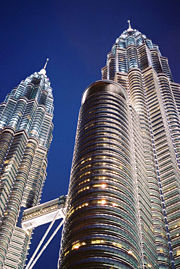
The architecture of Kuala Lumpur is a blend of old colonial influences, Asian traditions, Malay Islamic inspirations, modern, and postmodern architecture mix. Being a relatively young city compared with other Southeast Asian capitals such as Bangkok, Jakarta and Manila, most of Kuala Lumpur's colonial buildings were built toward the end of the 19th and early 20th centuries. These buildings have Moorish, Tudor, Neo-Gothic or Grecian-Spanish style or architecture. Most of the styling has been modified to use local resources and acclimatised to the local climate, which is hot and humid all year around.
Prior to the Second World War, many shophouses, usually two storeys with functional shops on the ground floor and separate residential spaces upstairs, were built around the old city centre. These shop-houses drew inspiration from Straits Chinese and European traditions. Some of these shophouses have made way for new developments but there are still many standing today around Medan Pasar (Old Market Square), Chinatown, Jalan Tuanku Abdul Rahman, Jalan Doraisamy, Bukit Bintang and Tengkat Tong Shin areas.
Independence coupled with the rapid economic growth from the 1970s to the 1990s and with Islam being the official religion in the country, has resulted in the construction of buildings with a more local and Islamic flavour arise around the city. Many of these buildings derive their design from traditional Malay items such as the songkok and the keris. Some of these buildings have Islamic geometric motifs integrated with the designs of the building, signifying Islamic restriction on imitating nature through drawings. Examples of these buildings are Menara Telekom, Menara Maybank, Dayabumi Complex, and the Islamic Centre. Some buildings such as the Islamic Arts Museum Malaysia and National Planetarium have been built to masquerade as a place of worship, complete with dome and minaret, when in fact it is a place of science and knowledge. The 452 metre tall Petronas Twin Towers were designed to resemble motifs found in Islamic art.
Late modern and postmodern architecture began to appear in the late-1990s and early- 2000s. Buildings with all glass shell appears around the city, with the most prominent example being the Petronas Twin Towers and Kuala Lumpur Convention Centre.
Kuala Lumpur’s central business district today has shifted around the Kuala Lumpur city centre (KLCC) where many new and tall buildings with modern and postmodern architecture fill the skyline.
Parks
The Perdana Lake Gardens, a 92 hectare manicured garden near the Malaysian Parliament building, was once home to a British colonial official. The park includes a Butterfly Park, Deer Park, Orchid Garden, Hibiscus Garden and Kuala Lumpur Bird Park, Southeast Asia's largest bird park. Other parks in the city include, the ASEAN Sculpture Garden, Kuala Lumpur City Centre Park (KLCC), Titiwangsa Lake Gardens, Metropolitan Lake Gardens in Kepong, Forest Research Institute Malaysia, Taman Tasik Permaisuri (Queen’s Lake Gardens), Bukit Kiara Botanical Gardens, Equestrian Park and West Valley Park near TTDI, and Bukit Jalil International Park.
There are three forest reserves within the city namely the Bukit Nanas Forest Reserve in the city centre, the oldest gazetted forest reserve in the country (10.52 hectares), Bukit Sungai Putih Forest Reserve (7.41 hectares) and Bukit Sungai Besi Forest Reserve (42.11 hectares). Bukit Nanas, in the heart of the city centre, is one of the oldest virgin forests in the world within a city. These residual forest areas are home to a number of fauna species particularly monkeys, tree shrews, squirrels and birds.
Culture
Arts
Kuala Lumpur is a hub for cultural activities and events in Malaysia. Among the centres is the National Museum which is situated along the Mahameru Highway. Its collection comprises artifacts and paintings collected throughout the country.
Kuala Lumpur also has an Islamic Arts Museum which houses more than seven thousands Islamic artefacts including rare exhibits from China as well as a library of Islamic art books. This museum features some impressively decorated domes and large open exhibition spaces. It is located at Jalan Lembah Perdana next to the National Mosque.
The premier performing arts venue is the Petronas Philharmonic Hall. The resident orchestra is the Malaysian Philharmonic Orchestra (MPO), consisting of musicians from all over the world and features regular concerts, chamber concerts and traditional cultural performances.
The National Art Gallery of Malaysia is located on Jalan Temerloh, off Jalan Tun Razak on a 5.67 hectare site neighbouring the National Theatre ( Istana Budaya) and National Library. The architecture of the gallery incorporates elements of traditional Malay architecture, as well as contemporary modern architecture. The National Art Gallery serves as a centre of excellence and trustee of the national art heritage.
The Petronas Art Gallery, another centre for fine art, is situated in Kuala Lumpur City Centre (KLCC). The Galeri Tangsi near Dataran Merdeka houses exhibitions of works by local and foreign artists.
The Kuala Lumpur Performing Arts Centre (KLPac) in Sentul West is one of the most established centres for the performing arts, notably theatre, music, and film screening, in the country. It has housed many local productions and has been a supporter of local and regional independent performance artists. One of the highlights in 2006 was the KL Sing Song 2006 music fest which featured Malaysian singer-songwriters of various cultural backgrounds, from both West and East Malaysia, through two days of performances and workshops.
Kuala Lumpur holds the Malaysia International Gourmet Festival annually. Another event hosted annually by the city is the Kuala Lumpur Fashion Week, which includes international brands as well as local designers.
Sports and recreation
Kuala Lumpur has numerous parks and open spaces for recreational purposes. Total open space for recreational and sport facilities land use in the city has increased significantly by 169.6 percent from 586 hectares in 1984 to 1,580 hectares in 2000.
Kuala Lumpur is one of the host cities for the Formula One World Championship, the open-wheel auto racing A1 Grand Prix and the Motorcycle Grand Prix with races being held at Sepang International Circuit in the neighbouring state of Selangor, next to the Kuala Lumpur International Airport. The Formula One event contributes significantly to tourist arrivals and tourism income to Kuala Lumpur. This is evident during the Asian Financial Crisis in 1998. Despite cities around Asia suffering declining tourist arrivals, Kuala Lumpur tourist arrivals increased from 6,210,900 in 1997 to 10,221,600 in 2000, or 64.6% increase in tourist arrivals.
KL Grand Prix CSI 5*, a five-star international showjumping equestrian event is held annually in the city. This annual event draws the world’s top riders and their prized horses to Malaysia.
Other annual sport events hosted by the city include the KL Tower Run, the KL Tower International BASE Jump Merdeka Circuit and the Kuala Lumpur International Marathon. Kuala Lumpur is also one of the stages of the Tour de Langkawi cycling race.
The annual Malaysia Open Super Series badminton tournament is held in Kuala Lumpur.
Kuala Lumpur has a considerable array of sports facilities of international class after hosting the 1998 Commonwealth Games. Many of these facilities including the main stadium (with running track and a football field), hockey stadium and swimming pools are located in the National Sports Complex at Bukit Jalil while a velodrome and more swimming pools are located in Bandar Tun Razak, next to the Taman Tasik Permaisuri Lake Gardens. There are also soccer fields, local sports complexes, swimming pools and tennis courts scattered around the suburbs. Badminton and ‘takraw’ courts are usually included in community halls.
Kuala Lumpur has several golf courses including the Kuala Lumpur Golf and Country Club (KLGCC) and the Malaysia Civil Service Golf Club in Kiara and the Berjaya Golf Course at Bukit Jalil.
The city also has numerous large private fitness centers run by California Fitness, Fitness First, Celebrity Gym, True Fitness and the major five star hotels.
Transportation
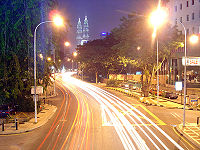
Unlike most other Asian cities, driving is the main mode of commuting in Kuala Lumpur. Hence, every part of the city is well connected by highways. As capital of Malaysia, Kuala Lumpur has a comprehensive road network that leads to the rest of Peninsular Malaysia. High speed roadways, or expressways are tolled roadways, and motorist using these expressways have an option of paying by cash, or by stored value cards such as Touch 'n Go and SmartTAG.
In terms of air connectivity, Kuala Lumpur is served by two airports. The main airport, Kuala Lumpur International Airport (KLIA), which is also the aviation hub of Malaysia, is located about 50 km south of city. The other airport is Subang Airport which used to be the main international airport serving the city until KLIA replaced it when it opened in 1998. The airport connects the city with direct flights to destinations in six continents around the world, and is the main hub for the national carrier, Malaysia Airlines. KLIA can be reached using the KLIA Ekspres high-speed train service from KL Sentral which takes only twenty-eight minutes, while travelling by car via highway will take about an hour. As of 2007, Subang Airport is only used for chartered and turboprops flights by airlines such as Firefly and Berjaya Air.
Public transport on Kuala Lumpur and the rest of the Klang Valley covers a variety of transport modes such as bus, rail and taxi. Despite efforts to promote usage of public transportation, utilisation rates are low as only 16 percent of the population used public transportation in 2006. The rapid transit system in Kuala Lumpur consists of three separate rail systems which meet in the city and extends towards other parts of Klang Valley. The rail systems are RapidKL RAIL, KL Monorail, and KTM Komuter. These lines have either underground or elevated stations around the city. The main rapid transit hub is KL Sentral which facilitates as an interchange station for the rail systems. KL Sentral is also a hub for intercity railway operated by KTM Intercity. It provides rail services to as far as Singapore in the south, and Hat Yai, Thailand, in the north.
The largest public transportation operator in Kuala Lumpur and the Klang Valley is RapidKL. Since the take over from Intrakota Komposit Sdn Bhd, RapidKL has redrawn the entire bus network of Kuala Lumpur and Klang Valley metropolitan area to increase ridership and improve Kuala Lumpur's public transportation system. The management of RapidKL has adopted the hub and spoke system to provide greater connectivity, and cut down the need of more buses. RapidKL is also the operator of three rapid transit rail lines in Kuala Lumpur, namely Ampang Line, Sri Petaling Line and Kelana Jaya Line.
Kuala Lumpur is served by Port Klang, located about 64 km (40 mi) southwest of the city. The port is the largest and busiest in the country handling about 6.3 million twenty-foot equivalent units (TEU) of cargo in 2006.
Education
According to government statistics, Kuala Lumpur has a literacy rate of 97.5% in 2000, the highest rate in any state or territory in Malaysia. In Malaysia, Malay is the language of instruction for most subjects while English is a compulsory subject and is used as the language of instruction for mathematics and the natural sciences. There are also schools which provide Mandarin and Tamil as languages of instruction for certain subjects.
In Kuala Lumpur alone, there are 13 tertiary education institutions, 79 high schools, 155 elementary schools and 136 kindergartens.
There are several notable institutions located in the city which have existed for more than 100 years, such as, St. John's Institution (since 1904); Victoria Institution (1893); Convent Bukit Nanas (1899); Methodist Girls' School, Kuala Lumpur (1896) and Methodist Boys' School (1897).
Kuala Lumpur is home to the University of Malaya. Established in 1962, it is the oldest university in Malaysia, and one of the oldest in the region. It is also the most prestigious tertiary institution in Malaysia, having been ranked first among the universities in Malaysia in the 2004 THES international rankings. In recent years, the number of international students at University of Malaya has risen, a result of increasing efforts made to attract more international students.
Other universities located in Kuala Lumpur include International Medical University, Open University Malaysia, Universiti Kuala Lumpur, Wawasan Open University and the branch campus of Universiti Kebangsaan Malaysia and Universiti Teknologi Malaysia. Apart from these, universities located around Kuala Lumpur include Monash University Malaysia Campus, Taylor's University College, Limkokwing University Of Creative Technology and others.
The National Defence University of Malaysia is located at Sungai Besi Army Base, at the southern part of central Kuala Lumpur. It was established to be a major centre for military and defence technology studies. This institution covers studies in the field of army, navy, and air force.
Twinned cities
 Ankara, Turkey
Ankara, Turkey Casablanca, Morocco
Casablanca, Morocco Esfahan, Iran
Esfahan, Iran Malacca, Malaysia (April 15, 1989)
Malacca, Malaysia (April 15, 1989) Mashhad, Iran (October 2006)
Mashhad, Iran (October 2006) Osaka, Japan
Osaka, Japan
